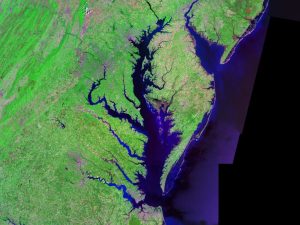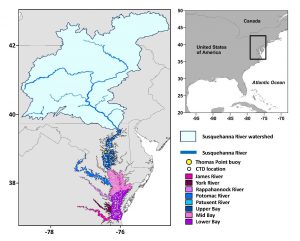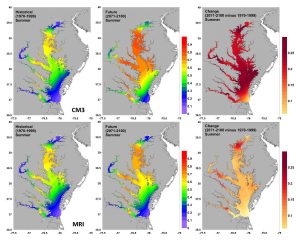26 September 2017
Warming climate could increase bacterial impacts on Chesapeake Bay shellfish, recreation
Posted by Lauren Lipuma

A satellite image of the Chesapeake Bay and its major tributaries. New research finds three common species of Vibrio bacteria in the Chesapeake Bay could increase with changing climate conditions by the end of this century.
Credit: NASA/Landsat.
by Shelley Dawicki
Researchers have found that three common species of Vibrio bacteria in the Chesapeake Bay could increase with changing climate conditions by the end of this century, resulting in significant economic and healthcare costs from illnesses caused by exposure to contaminated water and consumption of contaminated shellfish.
Vibrio bacteria occur naturally in the Chesapeake Bay and in coastal and estuarine waters around the world. About a dozen Vibrio species can cause human illness, known as vibriosis. Two of the most common species causing human illness in the United States, Vibrio parahaemolyticus and Vibrio vulnificus, occur in the Chesapeake Bay. Their abundance varies with water temperature, salinity and other environmental factors. A third species, Vibrio cholerae, also occurs in Chesapeake Bay but is not associated with cholera epidemics, although like other Vibrio species it can sometimes cause illness in people who eat contaminated shellfish, such as oysters.
In a new study, researchers used four different global climate models and data from eight locations in and around the bay and its tributaries to project how warming temperatures and changing freshwater inputs might impact the three Vibrio bacteria in the bay and its oyster populations by the end of this century. The findings showed substantial future increases in the occurrence, distribution and length of the season for V. vulnificus and V. parahaemolyticus, and an increase in favorable habitat for V. cholerae, although this was confined to low salinity regions of the bay. The findings are published in GeoHealth, a journal of the American Geophysical Union.
“Recent research from other parts of the world has suggested that warming conditions due to climate change have led to more favorable conditions for Vibrio-related disease outbreaks,” said Barbara Muhling, formerly at NOAA’s Geophysical Fluid Dynamics Laboratory at Princeton University and currently at the Cooperative Institute for Marine Ecosystems and Climate (CIMEC) in Santa Cruz, California. “There are relatively few studies like ours that use projections from IPCC-class climate models to examine the risk of future Vibrio species occurring and appearing in new areas, or the rates of human infection.”
IPCC, the Intergovernmental Panel on Climate Change, is the international body that reviews and assesses the most recent scientific, technical, and socio-economic information produced worldwide relevant to the understanding of climate change. CIMEC is a partnership of ocean, climate and ecosystem research between NOAA and several California universities.

A map showing the study area, the Susquehanna River watershed, the location of the Thomas Point buoy, and the Chesapeake Bay and major tributaries.
Credit: Muhling et al/GRL/AGU.
“We used Vibrio, given its potential impact on the Chesapeake Bay, as the first case study for this new downscaling framework,” said Vincent Saba, a NOAA Fisheries researcher who works with high resolution global climate models at NOAA’s Geophysical Fluid Dynamics Laboratory in Princeton, New Jersey and co-author of the new study. “People are interested in knowing what could happen in their own backyard, so this was a great application of the downscaling framework we have developed. Other species can be studied using this same method where estuary temperature, salinity, and river flow are important factors.”
Laboratory experiments suggest that optimum temperatures for Vibrio species are between 37 and 39 degrees Celsius, or 98.6 to 102.2 degrees Fahrenheit, much warmer than current conditions in the Chesapeake Bay.
All three Vibrio strains now occur more frequently and in higher abundances in warmer months of the year, when water temperatures are also warmer. Each strain or species appears to have a distinct salinity range, meaning the Vibrios could potentially increase only when other environmental factors are or become favorable in a specific area in the bay.
“I was a bit surprised at how important salinity was for the projections,” Muhling said. “While warmer waters are generally more favorable for Vibrios, salinity can determine the likely locations of future hot-spots. As a result, the projected increases in V. cholerae were much lower and more spatially restricted than for the other two Vibrio species we looked at.”

Projections of historical (1970 – 1999) and future (2071 – 2100) probability of summer (July – September) V. vulnificus occurrence in the Chesapeake Bay from two statistically downscaled GCMs (CM3 and MRI). The change between the two time periods is also shown.
Credit: Muhling et al/GRL/AGU.
Disease risk from Vibrios already exists in the Chesapeake Bay. Environmental and resource managers are aware of it, as are many local residents and shellfish consumers. Some measures designed to reduce the risk of Vibrio-related illness from harvested oysters are already in place. For example, in warmer months, oysters must be refrigerated by a certain time of day after being harvested. As temperatures continue to warm, these set times of day may need to be adjusted to ensure that oysters remain safe to eat. The months of the year where these regulations are applied may also need to be extended.
“Our results show the need for models of climate impact on Vibrios in estuarine environments,” Muhling said. “Economic costs associated with Vibrios in the Chesapeake Bay, such as the occurrence of illness or management actions to adapt to the changing conditions, may increase under climate change. That has implications for recreational and commercial uses of this ecosystem.”
Since many commercial and recreational fisheries species use estuaries during their life cycle, the downscaled climate framework used on Vibrio could be applied to them as well. “Our next steps will be to look at the impact of changing climate on species like blue crabs, striped bass, black sea bass, or river herring and apply the framework to other estuarine areas in the Northeast, like Delaware Bay and Long Island Sound,” Saba said. “We’d also like to look at forecasting possibilities and how that could be used to inform fisheries management.”
— Shelley Dawicki is a science writer/communications specialist at NOAA’s Northeast Fisheries Science Center in Woods Hole, Massachusetts. This post originally appeared as a press release on the NOAA website.



 GeoSpace is a blog on Earth and space science, managed by AGU’s Public Information staff. The blog features posts by AGU writers and guest contributors on all sorts of relevant science topics, but with a focus on new research and geo and space sciences-related stories that are currently in the news.
GeoSpace is a blog on Earth and space science, managed by AGU’s Public Information staff. The blog features posts by AGU writers and guest contributors on all sorts of relevant science topics, but with a focus on new research and geo and space sciences-related stories that are currently in the news.